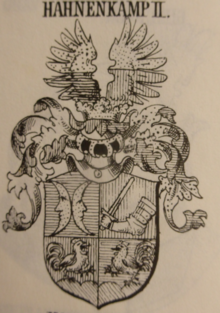Schirmitz Castle
Schloss Schirmitz is an abandoned castle next to the church in the center of the Upper Palatinate community of Schirmitz .
history
A Marcward von Schirnwitz was first mentioned around 1225 as a witness when Diepold II von Leuchtenberg pledged the Leuchtenberg Castle to Heinrich von Ortenburg-Murach . It can therefore be assumed that the Schirnwitz ministerials were the Leuchtenbergers. In 1280 a Fridericus de schirenwitz documents when Landgrave Friedrich II renounces his right to property in Pischeldorf (now part of Pirk ); In 1320 and 1323 Friedrich der Schirmitzer appeared as a witness in documents from the Kastl monastery .
Eysentrud of Nothafft received a court in Schirmitz as she Landgrave Friedrich von Leuchtenberg married. This farm was an imperial fiefdom and came to the Waldsassen monastery in 1297 . A local parish (St. Jacob) is mentioned in the oldest parish directory of the Diocese of Regensburg in 1326 at the ministerial seat of Schirmitz . At that time, Schirmitz was part of the Schwarzhofen dean's office . On December 19, 1399, Heinrich der Alber , who sat at Schirmitz, was named in the oldest Leuchtenberg fief book , and he was sold a property behind the church, known as Kolbenhof; this is confirmed again on March 7, 1407 to Mrs. Agnes der Alberin . On May 9, 1445, Konrad Alber , who was sitting at Schirmitz, was named when selling a tithe . On April 9, 1488, Fridel Alber von Schirmitz received a fiefdom letter from Landgrave Johann .
The other Schirmitzer estate owners are documented from 1568 onwards: In 1568 Christoph von Trauttenberg from Fuchsmühl is mentioned here . He was followed in 1590 by Sebastian Wildenauer, known as Kastner, and in 1612 by Johann Sebastian Wildenauer, known as Kastner . For Sebastian Wildenauer, called Kastner , a letter of freedom is issued on August 16, 1590. On February 13, 1717, Johann Joachim Grill resigned from the compulsory state estate for the estate Schirmitz, which he had bought. His successor, Max Emanuel Grill, sells the estate to the Leuchtenberg district court clerk Johann Melchior Hannakam , who resigns from the compulsory estate on October 2, 1724. Between 1732 and 1740 Anna Maria Hannakamp is mentioned here . On July 8, 1747, the Hanakamps were raised to imperial nobility with the addition of Schirmitz . In 1746 the country estate passed to Johann Max de Friderico († 1749). When the inventory is taken, the Schloss zu Schirmitz is also named with all its affiliations. In the middle of the 18th century, the hearth description belonging to the Leuchtenberg district court, which is essentially based on the Leuchtenbergian Salbuch from 1719, mentions a castle, a Meierhof and 34 properties in Schirmitz, some of which belong to the Schirmitz estate and some to the manor of the parish Schirmitz belonged to. Between 1750 and 1761 the estate was in the hands of the widowed Landobristin or Lieutenant General Field Marshal Maria Magdalena de Friderico (born von Kornbeckh , † February 6, 1766). On February 11, 1754, Elector Maximilian Joseph confirmed her freedom of the landlords for life because of the merits of her deceased husband. On January 30, 1765, the "freed manor" with the castle and 22 quarter courtyards was donated by Johann Leonhardt de Friderico to Count Joseph Franz von Seinsheim . He was followed in 1771 by Maria Josepha Freyin von Hannakamp , who bought the country estate again. Her daughter, married Baroness von Karg , sold the noble residence with castle, farm and mill in 1772 to the Waldsassen monastery for 13,000 fl . In 1801 the Amberg government gave the estate Schirmitz to the patron Jews Michael Hirschel et Cons. for 36,000 florins handed over for dismantling and sale, which had already been initiated by the Waldsassen monastery in 1799. In 1803 the country estate was divided up and sold.
The owners of the country estate exercised the lower jurisdiction . Since the monastery was secularized and confiscated by the state in 1803 , a patrimonial court was no longer established here . Schirmitz belonged to the city court Weiden, which in turn was subordinate to the district judge von Parkstein ; In 1838 it was incorporated into the Vohenstrauß Regional Court and from 1862 it belonged to the Neustadt an der Waldnaab district .
The Heigl Castle Brewery later stood on the site of the abandoned castle.
literature
- Our district: home book of the district Neustadt an d. Waldnaab. Home register of the district of Neustadt an d. Waldnaab, p. 75. Michael Lassleben, Kallmünz 1960.
- Adolf Wolfgang Schuster : Home chronicle of the community of Schirmitz. Schirmitz municipality, Schirmitz 1998.
Web links
Individual evidence
- ↑ Dieter Bernd: Vohenstrauss . In: Historical Atlas of Bavaria , part of Old Bavaria . Series I, issue 39. Komm. Für Bayerische Landesgeschichte, Munich 1977, ISBN 3-7696-9900-9 , p. 68 or 73 ( digitized version ).
- ↑ Adolf Schuster, 1988, pp. 90–91.
- ↑ Dieter Bernd: Vohenstrauss . In: Historical Atlas of Bavaria , part of Old Bavaria . Series I, issue 39. Komm. Für Bayerische Landesgeschichte, Munich 1977, ISBN 3-7696-9900-9 , p. 160 ( digitized version ).
- ↑ Dieter Bernd: Vohenstrauss . In: Historical Atlas of Bavaria , part of Old Bavaria . Series I, issue 39. Komm. Für Bayerische Landesgeschichte, Munich 1977, ISBN 3-7696-9900-9 , p. 165 ( digitized version ).
- ↑ Dieter Bernd: Vohenstrauss . In: Historical Atlas of Bavaria , part of Old Bavaria . Series I, issue 39. Komm. Für Bayerische Landesgeschichte, Munich 1977, ISBN 3-7696-9900-9 , p. 160 or 176 ( digitized version ).
- ^ Felix Mader (arrangement): Die Kunstdenkmäler von Bayern , Heft IX. The art monuments of Upper Palatinate & Regensburg, Volume IX, District Office Neustadt an der Waldnaab. 1907 (reprinted by R. Oldenbourg Verlag , Munich 1981), p. 120.
Coordinates: 49 ° 39 '12.3 " N , 12 ° 10' 11" E


